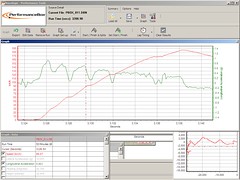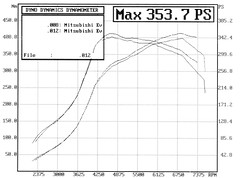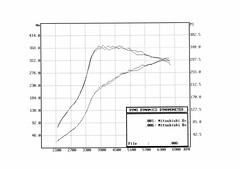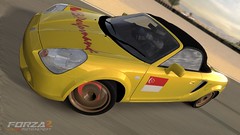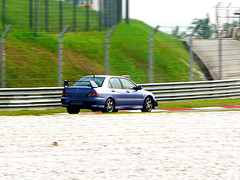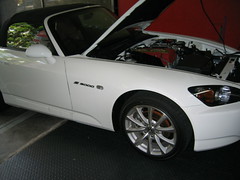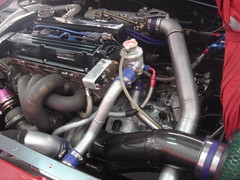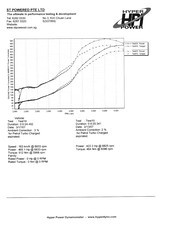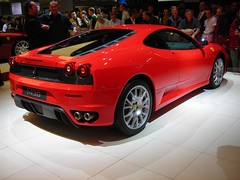Monday, December 17, 2007
0 to 160 km/h test
Anyway here are some tests done on an full-weight Evo 8. Figures include gear shift times:
130-160 km/h: 2.17s
120-150 km/h: 2.10s
110-140 km/h: 2.3s
100-130 km/h: 2.15s
90-120 km/h: 2.08s
80-110 km/h: 1.92s
70-100 km/h: 1.85s
60-90 km/h: 1.79s
50-80 km/h: 1.80s
40-70 km/h: 1.72s
30-60 km/h: 1.38s
20-50 km/h: 1.33s
10-40 km/h: 1.30s
4th gear:
140-169 km/h: 2.31s
130-160 km/h: 2.15s
120-150 km/h: 2.07s
110-140 km/h: 1.98s
100-130 km/h: 1.96s
90-120 km/h: 2.06s
80-110 km/h: 2.58s
GT35R, no alcohol/nitrous/race gas/water injection, 1.7 bar boost, street tires.
Wednesday, December 05, 2007
Spam Sieve statistics
###
Filtered Mail
2,351 Good Messages
23,698 Spam Messages (91%)
31 Spam Messages Per Day
SpamSieve Accuracy
15 False Positives
202 False Negatives (93%)
99.2% Correct
Corpus
571 Good Messages
1,307 Spam Messages (70%)
91,175 Total Words
Rules
676 Blocklist Rules
982 Whitelist Rules
Showing Statistics Since
11/22/05 18:47
Friday, November 30, 2007
"Right" way vs "a(ny)" way
It still blows my mind how different Japan is compared to the rest of the world. The attention to the most minute of details, pride in their work, professionalism, sense of duty and honor etc is so deeply ingrained in their consciousness, it's no wonder senior executives would choose to end their lives than to suffer the ignominy of being tried and convicted of white-collar crimes.
Wednesday, November 21, 2007
Tuesday, November 20, 2007
EJ257 dyno

Dotted lines represent the projected torque and power values using linear regression if there was no clutch slip. Data are unaltered as produced by the dyno machine and input into Excel for analysis.
The original chart is here.
According to the graph, peak power is at 5718 RPM. Assuming ideal conditions, a 2.5L engine would flow about 530 cfm of air at 1.1 bar of boost pressure... about 366 crank horsepower. This compares favorably with the 290 PS measured at wheels, and sounds pretty reasonable for 4WD drivetrain loss while also taking the clutch slip into account.
Dyno Dynamics: some math
Calculated torque (Nm) = Tractive Effort (N) * Roller radius (m)
Roller speed (RPM)= (Vehicle speed (km/h) * 1000) / 60 / Roller circumference (m)
Torque at wheels (Nm) = Calculated torque (Nm) / (Engine speed/Roller speed)
Power at wheels (PS) = Torque at wheels (Nm) * Engine speed (RPM) / 7020
Example:
Roller diameter: 0.217m
Roller circumference: 0.681726m
Vehicle speed: 130 km/h
RPM: 5417
Tractive Effort: 7866 N
Calculated torque = 7866 * (0.217/2) = 853.461 Nm
Roller speed = 130 * 1000 / 60 / 0.681726 = 3178.207 RPM
Torque at wheels = 853.461 / (5417/3178.207) = 500.734 Nm
Power at wheels = 500.734 * 5417 / 7020 = 386.4 PS
Wednesday, November 14, 2007
The Tuner Market is Dead
Kent’s aforementioned entry brought up the age-old argument that people need to stop buying cheap parts. For those of you who didn’t read his entry, he basically says “People who buy the cheap parts ruin the market and hurt the industry as a whole. People need to be educated about high quality product because if they learn about why a product is high quality then they won’t want the cheap stuff anymore.” For a long time, I too was an avid believer and supporter of those ideals. But recently, things have changed. In order to explain what my beliefs are I must first define “The Tuner Market” as what most people see as our aftermarket industry. Whether you modify your car for street, show, drift, drag, road race or time attack, you’re a part of the “tuner market.”
Very well-written article and I agree with most of his points.
Tuesday, November 13, 2007
Cal physicists make a radio 10,000 times thinner than a human hair
Professor Alex Zettl led a team that developed the minuscule filament, which can be tuned to receive AM or FM transmissions.
The first song it played? "Layla" by Derek & the Dominos. Eric Clapton's unmistakable guitar riff can be heard on a scratchy recording of the nanoradio's output posted by Zettl online.
Monday, November 12, 2007
NGD test
Your Score: Pure Geek
39 % Nerd, 65% Geek, 30% Dork
For The Record:
A Nerd is someone who is passionate about learning/being smart/academia.
A Geek is someone who is passionate about some particular area or subject, often an obscure or difficult one.
A Dork is someone who has difficulty with common social expectations/interactions.
You scored better than half in Geek, earning you the title of: Pure Geek.
It's not that you're a school junkie, like the nerd, and you don't really stand out in a crowd, like the dork, you just have some interests that aren't quite mainstream. Perhaps it's anime, perhaps it's computers, perhaps it's bottlecaps, perhaps it's all of those and more. Your interests take you to events and gatherings that are filled with people you find unusual and beyond-the-pale, but you don't quite consider yourself "of that crowd." Instead, you consider yourself to be fairly normal.
Which, you are.
Congratulations! You're the one on the RIGHT!
###
So my self-assessment was spot on. :)Sunday, November 11, 2007
Monday, November 05, 2007
Sandbox: Meme, meme, meme
According to the meme:
i. Grab the nearest book.
ii. Open the book to page 123.
iii. Find the fifth sentence.
iv. Post the text of the sentence in your journal along with these instructions.
v. Don't search around and look for the "coolest" book you can find. Do what's actually next to you.
Here's what I've got:
This state is detected by a third pair of piezoelectric elements 3-3'.
Sunday, November 04, 2007
View from Aqa Hotel, Nagano, Japan
In Japan, humanity coexists with Nature in harmony. Everyone is extremely mindful of the impact of their actions on the environment. I've been to a lot of developed countries where the government pays lip service to eco-friendly initiatives, but Japan in my mind is far ahead of everyone. I didn't even go specifically for sightseeing but the panoramic views took my breath away. I'm equally impressed by Nature's majesty as well as human ingenuity; from the humbling peaks of faraway mountains to the massive bridges spanning large expanses of water... it is in a word, magical.
Japanese people are extremely polite and disciplined. They have a very powerful work ethic, even so-called menial tasks such as arranging travel brochures do not escape their attention to detail.
By extension the country is astonishingly clean. Temples in Asia are notoriously dusty affairs but those that I've seen in Japan are polar opposites. There is no dust under the eaves. There are no cobwebs in forgotten corners. It's so mind-blowingly amazing it has to be seen to be believed. Yet for its cleanliness, some people still spit on the streets to clear their nasal passages and everything still goes on with nary a raised eyebrow! It's exactly this sort of juxtaposed incongruity that has me bewildered.
Tokyo residents generally are over-dressed. The weather was perfect, in the low 20s, yet everyone has a jacket on. Except for the crazy schoolgirls with their impossibly short skirts. Don't ask me how they keep their rear ends warm in the height of winter. I seriously have no clue.
Japanese love white cars. And big Mercedes-Benzes, like the S500 or the E55. Oh and the MkIV Supra and the Mazda RX-7, pretty amazing considering that these cars have been out of production for many years. Tons of them. Evos aren't very popular there. I've seen at most 10 cars, of the various generations. The Subaru Impreza doesn't fare significantly better, most are in the rally blue but I did catch sight of an S204. Porsche seems to be doing very well. Saw 2 Ferrari F430, a 360 Challenge Stradale and a handful of Lamborghinis. Just one yellow Corvette C6 Z06.
OK I'll stop for now. Maybe more in the next entry. In the meantime the photo collection is up, and I'll be adding comments and descriptions as I get more time.
Saturday, October 27, 2007
Ferrari FXX - Michael Schumacher
Vid of Michael Schumacher's unique black Ferrari FXX @ Magny Cours with Zinédine Zidane as passenger.
Wednesday, October 24, 2007
Crash settled for US$4.5M
Monday, October 22, 2007
Tragicomedy
"And then they'll train gorillas to go after the langurs. Pretty soon they'll be dodging [lions] that are fighting rhinos."
Direct to DVD... Animal Planet: The World at War Edition.
Thursday, October 18, 2007
353.7 PS at wheels
This set of cams is superior in every way to the stock cams; there was no loss in torque, and there was significant increase in power in the entire rev range after 3600 RPM.
After reprogramming the ECU the car eventually made almost 40 PS at wheels more than when it came in at the same boost levels, and on the same petrol.
As a frame of reference, a 2.5L WRX STI with 265 PS at crank does about 210 PS at wheels on this dyno.
Update: Due to the an input error in the dyno's gear ratio calculation, the measured torque is underrated by 5.8%! Horsepower remains the same. The corrected peak torque figure measured at wheels should be 441 Nm @ 4422 RPM.
Monday, October 15, 2007
Age of the Amateurs
Today, the ubiquity of software to reprogram one's engine computer is a reality. However the old adage applies: a little knowledge can be a dangerous thing.
Recently I had the dubious distinction of having to explain to a testy individual about following advice from dubious sources. This person was trying to rescale the MAF resolution by changing the A/D counts and other related parameters by a fixed factor. However he quickly turned defensive when the obvious was pointed out: there was incomplete information as to whether the MAF sensor would still respond with a linear voltage given the increase in mass airflow. Whereupon this person quickly accused me of being disrespectful, discourteous, sarcastic etc. The typical Singaporean knee-jerk response to someone who holds a differing viewpoint. Possibly because he is now charging $140 per tune, whereas the market rate for a professional tune is anywhere from $500 onwards, with $1000 being the average. i.e. monetary interest in appearing to be correct at all times.
A relevant section from John Mandel's "The Statistical Analysis of Experimental Data" is appropriate:
#####
The methods of statistical analysis are intimately related to the problems of inductive inference: drawing inferences from the particular to the general. R.A. Fisher, one of the founders of the modern science of statistics, has pointed to a basic and most important difference between the results of induction and deduction. In the latter, conclusions based on partial information are always correct, despite the incompleteness of the premises, provided that this partial information itself is correct. For example, the theorem that the sum of the angles of a plane triangle equals to 180 degrees is based on certain postulates of geometry, but it does not necessitate information as to whether the triangle is drawn on paper or on cardboard, or whether it is isosceles or not. If information of this type is subsequently added, it cannot possibly alter the fact expressed by the theorem. On the other hand, inferences drawn by induction from incomplete information may be entirely wrong, even when the information given is entirely correct. For example, if one were given the data of Table 2.1 on the pressure and volume of a fixed mass of gas, one might infer, by induction, that the pressure of a gas is proportional to its volume, a completely erroneous statement.
Table 2.1 Volume-Pressure Relation for Ethylene, an Apparently Proportional Relationship

The error is due, of course, to the fact that another important item of information was omitted, namely that each pair of measurements was obtained at a different temperature, as indicated in Table 2.2. Admittedly this example is artificial and extreme; it was introduced merely to emphasize the basic problem in inductive reasoning: the dependence of inductive inferences not only on the correctness of the data, by also on their completeness. Recognition of the danger of drawing false inferences from incomplete, though correct information has led scientists to a preference for designed experimentation above mere observation of natural phenomena.
Table 2.2 Volume-Pressure-Temperature Relation for Ethylene

#####
Just as one may be inclined to seek medical information on the Internet, it is still prudent to visit a licensed medical practitioner so that one's ailments may be properly diagnosed and treated. Would you let a "doctor" treat you just because he has read some medical books and charges a low fee?
The age of the amateur is upon us.
Howard Jones
Like to get to know you well
Like to get to know you well
Like to get to know you well
So we can be one
We can be one together
Repeat Chorus
Together we can cast away the fear
Together we can wipe away the tear
Together we can strip down the barriers
And be one
Don't wanna talk about the weather
Don't wanna talk about the news
Just wanna get to the real you inside
Repeat Chorus
Don't you think now is the time
We should be feelin'
Just wanna simply say
Won't let you slip away
People wanna talk about the future
Don't wanna linger on the past
Just wanna reach to the real you inside
Forget cold glances and rejections
Leave the things that separate
Build on a trust that we can stand on
Repeat Chorus
Finding all are insecure
Opening the same door
Leaving out a stubborn pride
Seeing from another side
Repeat Chorus
Saturday, October 06, 2007
Tuesday, October 02, 2007
New Supra MkV spotted at Nurburgring
Props to BK who sent me this link... sounds like a V10. Shaun thinks it's either a V10 or an even-fire V6 or I6 without turbo.
Ken: you see the big fat "Play" button? Click on it and the video will play. :)Saturday, September 29, 2007
Tales of integrity Part 2
Perhaps some day, someone would be patient enough to provide some insight as to what drives such demented individuals from spreading lies and FUD.
On the other hand, I've heard of people who offer free retunes if they do not improve upon a customer's car. The idea is that if this person does not increase your car by X horsepower from the baseline run, you don't have to pay anything. Such actions are operating on shaky ethical grounds and casts a long shadow on the professionalism of the industry as a whole.
First, the con artist usually owns the dyno facility, thus he is able to influence the base and subsequent dyno runs. Second, the con artist has full access to the ECU. This is akin to stealing someone else's intellectual property and passing it off as one's own. Even if the owner has full knowledge of such shenanigans, the con artist may not have a full appreciation of the situation as to why the car was not running at optimal states e.g. retarded spark advance at certain map points to avoid knock until the cause of the problem is determined. And thus it would appear that the "tuner" and the customer are both at fault.
So it seems that some customers are playing the tuners against each other, to great effect. And some tuners have no sense of professional ethics. Perhaps it's time that the tuners themselves get organized to settle such disputes and minimize these sort of situations altogether.
Thursday, September 27, 2007
Tales of integrity (or lack thereof)
Several years ago, I had the "pleasure" of having a so-called "friend" buy an aftermarket ECU from me at cost price, inclusive of the tuning etc. He was very pleased with the results and didn't seem to be dissatisfied at all, despite the typical teething problems with having a custom calibration done from scratch. When everything was completed he claimed that his finances were in disarray and so gave me a post-dated cheque of 1 month.
Within the week I started hearing rumors passed behind my back about my "poor job" done on the car; upon receiving this info I contacted him to enquire about his car, even going so far as to refund the cheque if he's not happy with things. He insisted that everything was OK but the rumors continued to persist. In the meantime I began to collate information about what he was saying behind my back, with SMS and MSN logs as proof. As this is going on remember I could not cash in the cheque!
Even after cashing in the cheque, the offer to refund the sum still stood, yet this person declined to come and meet me like a man, preferring to cast aspersions from behind a veil of deceit. It's unbelievable that this is how a so-called devout Christian behaves.
It's OK though. I rest easy at night because my conscience is clear. On the other hand, he has reason to fear, since I know where he lives. :)
Wednesday, September 19, 2007
Saturday, September 15, 2007
WMSC's flimsy case against McLaren
This is the WMSC's decision against McLaren (pdf) Some excerpts:
###
8.4 McLaren has made detailed submissions indicating that none of the information received enhanced the McLaren car. McLaren has suggested to the WMSC that unless “actual use” and a demonstrated and itemised performance advantage can be proven beyond a reasonable doubt (i.e. to a criminal law standard of proof), the WMSC is not permitted at law to impose a penalty.
8.5 The WMSC rejects this suggestion. The WMSC has full jurisdiction to apply Article 151(c) and stresses that it is not necessary for it to demonstrate that any confidential Ferrari information was directly copied by McLaren or put to direct use in the McLaren car to justify a finding that Article 151(c) was breached and/or that a penalty is merited. Nor does the WMSC need to show that any information improperly held led to any specifically identified sporting advantage, or indeed any advantage at all. Rather, the WMSC is entitled to treat possession of another team’s information as an offence meriting a penalty on its own if it so chooses.
8.12 The evidence leads the WMSC to conclude that some degree of sporting advantage was obtained, though it may forever be impossible to quantify that advantage in concrete terms.
###
So if a Ferrari waterboy were to tell his counterpart at McLaren that Kimi is using the Port-A-Potty before the race, the WMSC can take action. Excellent reasoning.
This is a witch hunt, plain and simple. Let's say a competing golf club manufacturer somehow managed to get hold of the technical plans behind Tiger Woods's clubs. In all other respects these competing clubs are within the specifications laid down by the rules. Would the PGA apply sanctions against this company? Ludicrous isn't it?
Another example. In other team sports such as American football or pro basketball, there are offensive and defensive playbooks which are crucial to a team's continued success. These playbooks have been known to go MIA but you don't see the sport's governing body coming down hard on the suspects. The same standards should apply in this particular case.
If Ferrari were to lose confidential information due to a disgruntled employee, then they should keep their own house in order before laying the blame on others. Unfortunately this is the reality of the world we live in; we look to blame others instead of looking at ourselves first.
Friday, September 14, 2007
AEM 50 psia (3.5 bar) MAP sensor
y = -0.0012x2 +85.036x -42.509; where y (kPa), x (V)
Tuesday, September 11, 2007
Monday, September 10, 2007
Found out recently that that a law enforcement officer cannot compel you to provide identification unless you're reasonably suspected of having committed a crime. So if you're minding your own business and a cop comes up to you and asks for ID, you are within your rights to just provide a name and address. You do not have to show him your IC. If you provide an overseas address, then you may be placed under arrest until it can be verified. (CPC, Sec 33-3).
Tuesday, September 04, 2007
Thursday, August 16, 2007
Evo X gear ratio comparison
| Evo X SST (6 speed) | Evo X 5 speed | Evo 8/9 6 speed | Evo 8/9 5 speed | |
| 1st | 58.1 | 64.4 | 63.7 | 67.3 |
| 2nd | 89.6 | 94.3 | 95.3 | 96.1 |
| 3rd | 121.0 | 127.3 | 129.2 | 129.8 |
| 4th | 160.5 | 167.8 | 168.4 | 171.0 |
| 5th | 210.5 | 241.6 | 213.4 | 246.3 |
| 6th | 273.8 | N/A | 267.3 | N/A |
Figures are in km/h with 7000 RPM limit.
Graphically:

Monday, August 06, 2007
Another day, another dyno run...
Boost is between 1.5 to 1.6 bar from 3500 to 6500 RPM, whereupon it drops to 1.4 bar.
Final numbers are 376.6 Nm @ 4000, 304.2 PS @ 6583. All figures are at wheels.
Analysis: 90% of peak torque is available over 34.6% of the rev range. 80% is available over 53.8% of the rev range.
Thursday, August 02, 2007
Fun-filled dyno day...
Somewhere between then and now, the car had new mods. ;)
Today was the day we found out just how effective they were. And this time we went to a Dyno Dynamics dyno, which reads notoriously low. A stock 2007 2.5L STI driven straight from the showroom will read 210 PS at wheels on this.
So the car is set up on the dyno and a small crowd gathers. The operator makes the base run and the line goes off the charts. No kidding. The operator has to rescale it to the 500 PS range and it shows 422 PS at wheels. Double that of a stock STI.
Next I get to work trying to bring up the mid-range and upper end... then we run into problems. It seems the injectors are running out of flow at the top, so it's back to the workshop to swap out for 950cc injectors.
After some time and it's back on the dyno. We make another base pull and now it's down to 310 PS at wheels. DAMN! The owner almost had a heart attack... :> He thought the momentary lean condition earlier in the day had hurt the engine.
So I get right to work with the new injectors... and in the next run the car immediately makes 422 PS again. That's how accurate this dyno is. We make a total of 16 pulls and it was accurate down to 0.1 PS every single time. Eventually we had to stop because the clutch was starting to slip... but it was a fruitful day since we managed to bring up the mid-range by 60+ PS at wheels... all this on 1.6 bar boost and 98 RON.
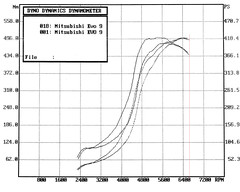
Click for larger view of the actual dyno sheet.
Here is the same data of the run but re-formatted as an Excel graph. With the wider x-axis the drop-off from peak torque does not appear as exaggerated. And this is where things get interesting: a reflashed Evo 9 does between 305 PS to 315 PS at 6500; this car is doing that at just 4700 RPM! From 4500 to 5000 RPM, the car gains an additional 108.8 PS at wheels! :) The torque stays above 460 Nm between 4750 to 6500. So when this car gets a full head of steam, it doesn't let up because the gear ratios are right on the money.

Sunday, July 15, 2007
Torque and HP for the umpteenth time
If this were true, F1 cars would have turbo-diesel engines and 40 speed gearboxes.
Perhaps the misunderstanding arises from the failure to understand the importance of the width of the power band and gearing. For race applications, you want as much torque to be developed as late as possible, for as long as possible. Why? Simply because horsepower is a function of both torque and RPM. So a high torque value at a high RPM will yield a higher HP figure. And if it's broad enough, you can make use of gearing to produce the desired torque at wheels.
Radical SR8LM
"Gotcha!" I hear you say. "Didn't you previously have a blog entry that stated 300 whp from a normally-aspirated 2.4L is improbable in the local context? So how do you explain a 2.8L engine doing almost 100 bhp more?"
Let's do the math.
Since Radical doesn't post up the power graph, let's assume peak power of 455 bhp is achieved at 10,000 RPM. This would yield a torque of 239 lb-ft at that engine speed. 2.8L is 171 cubic inches, so BMEP is 211 psi. Well within reason. By the way, Radical suggests an engine rebuild interval of 30 hours. This engine is not meant to be driven daily.
So logic prevails. I stick with what was stated previously and would require a lot more convincing that a daily-driven, locally built and tuned 2.4L normally aspirated engine revving to just 8000 RPM is capable of 300 whp.
Wednesday, June 06, 2007
Does Objective Reality Exist, or is the Universe a Phantasm?
The book highlights the research done by two eminent scientists, physicist David Bohm and neurosurgeon Karl Pribram. Faced with inexplicable experiences in their own specialized fields, these gentlemen independently stumbled upon the concept that all things; consciousness, the universe and reality itself, can be explained by a holographic model.
A fascinating and intriguing read. :)
Thursday, May 31, 2007
FM2 frenzy
The first vehicle that I purchased is the Toyota MR-S. Due to its light weight and perfect weight distribution it was an ideal platform to work from. After spending 40,300 credits' worth of parts, I eventually ended up with what you see here.
An "S" class go-kart with a performance index of 915 with about 453 bhp/ton, naturally aspirated. And it's not even maxed out yet... cos it's still on the mid-performance cams. Stats:
Power: 274 kW @ 7400
Torque: 404 Nm @ 5000
Weight: 806 kg
6 speed gearbox
Front tires: 215/35R17
Rear tires: 245/30R17
Wheels: Volk Racing CE28N
Posted a laptime of 56.977 seconds around Tsukuba without any tuning. :)
Saturday, May 26, 2007
Friday, May 25, 2007
Thoughts on MPT Sprint 2007 Rd 2
Descriptive statistics:
| Mean | 8.34657894736842 |
| Standard Error | 0.123470026 |
| Median | 8.285 |
| Mode | 8.27 |
| Standard Deviation | 0.761120356 |
| Sample Variance | 0.579304196 |
| Kurtosis | 0.060944713 |
| Skewness | 0.383091369 |
| Range | 3.25 |
| Minimum | 6.78 |
| Maximum | 10.03 |
| Sum | 317.17 |
| Count | 38 |
| Confidence Level (95.0%) | 0.250174034 |
It is human nature to always look at the outliers. True, at the end of the day, people don't remember who came in 3rd. However, we also have to consider that the cars we fielded are daily drivers. No shop cars. No sequential gearbox or dog boxes. Air-conditioning and heavy glass windows still intact and working. No carbon fiber doors. No drag slicks or treated tires. Hell, one of the drivers even showed up in Yokohama AD07s!
Look at the positive skewness: this means there's more data in the right tail than would be expected in a normal distribution. Make no mistake about it: the competition is tough!
Yet given these difficult circumstances, we managed to prevail against the odds.
The best performer is in the 64th percentile (i.e. it was quicker than 64% of the cars that took part in this event) and 2nd best, in the 59th percentile, with the 3rd car just above average. Not bad considering it was running on a stock Evo 9 titanium turbo and pump gas!
Hopefully we can further improve upon the results in the next round.
Tuesday, May 22, 2007
Interesting article on game theory
Lucy and Pete, returning from a remote Pacific island, find that the airline has damaged the identical antiques that each had purchased. An airline manager says that he is happy to compensate them but is handicapped by being clueless about the value of these strange objects. Simply asking the travelers for the price is hopeless, he figures, for they will inflate it.
Instead he devises a more complicated scheme. He asks each of them to write down the price of the antique as any dollar integer between 2 and 100 without conferring together. If both write the same number, he will take that to be the true price, and he will pay each of them that amount. But if they write different numbers, he will assume that the lower one is the actual price and that the person writing the higher number is cheating. In that case, he will pay both of them the lower number along with a bonus and a penalty--the person who wrote the lower number will get $2 more as a reward for honesty and the one who wrote the higher number will get $2 less as a punishment. For instance, if Lucy writes 46 and Pete writes 100, Lucy will get $48 and Pete will get $44.
What numbers will Lucy and Pete write? What number would you write?
Rest of Scientific American article here.
Monday, May 21, 2007
Sprint/SuperSprint 2007
Competition was stiff; expectations were low since there were no classifications for tires or weight. We only had 5 entrants, with 4 taking victories in both runs. And the dark horse, as predicted, turned in an upsetting result.
The crew had fun and it was definitely a learning experience for us.
Flickr photo set here.
Monday, May 14, 2007
FM2 preview
Having had some practice with the downloaded demo a couple of days earlier, and also having extensively played the first installment, it wasn't too much of an adjustment to get used to the controls again.
First, the good points. Graphically it has been cleaned up, with a much higher level of detail. New tracks, and more customization options. The audio, it's perfect. The exhaust of an E46 M3 roaring down the Nurburgring is exactly how it sounds like, with the unmistakable induction noise gaining in pitch around 6000 RPM. A stroked up 4G63 sounds exactly like the agricultural beast that it is.
Some things that I noticed: the SLR doesn't have the rear air brake popping up to assist in hard braking. The wireless steering wheel is a little too sensitive, making the wireless controller the de facto choice when really racing in earnest.
Definitely looking forward to this title when it launches on the 29th.
Sunday, May 13, 2007
Photoshop Magic (slightly NSFW)
Saturday, May 05, 2007
Through this period of time, it has seen me through break-ups, make-ups, good days and bad days.
As hard as I try not to form an emotional bond to a piece of metal, I can't but feel a slight twinge of regret that one day, some day, this beautiful relationship has to come to an end.
But it is not the perfect steed; it drinks gasoline like no tomorrow, and brake pads and rotors are changed on a regular basis. As I'm typing this, the (6th) clutch is starting to slip, and it was installed barely 2 months ago.
But would it have been worth it?
Without a doubt.
Saturday, April 28, 2007
Drove an S2K today
Steering is sharp and nicely weighted, suspension is firm, chassis is solid. Seating position is fairly low. Gear shift feel is excellent, clutch is light. Everything is within easy reach of the driver. Throttle response could be better. Torque is decent. Top end power is lacking though. Honestly can't see how folks can drive cars like this on the one hand and complain about "turbo lag" on the other.
Overall it is a decent, fun car. It's no highway monster that's for sure, but I can certainly see the owner enjoying a drive on twisty roads.
Sunday, April 22, 2007
Wednesday, April 18, 2007
Tuesday, April 17, 2007
Never take things for granted
We were a little surprised that the static compression was measured to be about 9:1 instead of the widely acknowledged 8.8:1...
| Bore | 85mm |
| Stroke | 88mm |
| Piston dish volume | 128cc |
| Cylinder head volume | 440cc |
| Head gasket thickness | 0.95mm |
| Head gasket bore | 85.5mm |
| Compression ratio | 9.021:1 |
Monday, April 16, 2007
Time Attack 2007
Making things worse were that the other heavy-hitters from various workshops were also no-shows, meaning that it was just like any other trackday. i.e., about as interesting for observers as watching paint dry.
Overall it was a disappointing trip... on the bright side we managed to average about 9.5 km/l on the car despite driving with a fairly heavy right foot.
Wednesday, April 11, 2007
How to tune an electronic boost controller
"Duty Cycle" is the duration of valve opening time vs the available opening time, expressed as a percentage. i.e., if the valve is always open, then duty cycle is 100%. Conversely, if the valve is always closed, then duty cycle is 0%. Here's where it can get confusing. Depending on how the boost control is set up, an "open" valve may open or close the wastegate. You must know which way the valve is set up to avoid over-boosting.
On a TYPICAL setup:
INTERNAL Wastegate:
Valve open (100% duty cycle) = More boost
Valve closed (0% duty cycle) = Less boost
EXTERNAL Wastegate:
Valve open (100% duty cycle) = Less boost
Valve closed (0% duty cycle) = More boost
The simplest form of boost control is using open loop wastegate duty. Specify a wastegate duty cycle, and you're done! In fact this is how a manual boost controller works. There's a valve that is controlled by spring pressure, once manifold pressure exceeds a certain level,it diverts the manifold pressure to open the wastegate, reducing boost.
Since we're dealing with electronic boost control, we can add another dimension such as gear, vehicle speed, RPM or other form of load signal or input voltage, to vary the wastegate duty. Obviously this feature is specific to each boost controller, some of the more basic ones do not have this function.
Next up is closed loop control. Instead of blindly following a fixed wastegate duty cycle, or varying it by an arbitrary load value, the boost controller can control boost by looking at the target boost, comparing it with actual boost, and change the boost as appropriate. In essence a PID or PD controller.
The "P" stands for "Proportional" gain. "I", "Integral" gain. "D" is "Derivative" gain.
The proportional gain is used to determine the rate of response to a change in boost pressure. If gain is too low, the targeted boost level will never be reached. If gain is too high, there will be overshoot. If gain is just right, it will reach the boost target but there may be slight fluctuations, depending on how quickly the boost changes. This is where the integral gain comes in. It will smooth out the fluctuations if it is set correctly. If integral gain is too high the boost will oscillate and go out of control. The derivative gain is used to further remove any errors from the "I" term. Depending on the complexity of your boost controller, you may not have to set the "I" and "D" terms.
Here's a practical example: Blitz SBC i-Color. For manual mode, all you need to do is program the "SET" and the "GAIN". "SET" refers to valve opening duty cycle. Again, it is critical that you know what a valve opening of "100" means for your own set-up. If your boost is fluctuating around the target or overshoots, then "GAIN" is probably too high. If you never meet the target boost, then "GAIN" is probably too low. Auto mode is the same except that you don't even need to program "SET", just your desired boost.
In this way, practically all electronic boost controllers are the same. The differences lie in the implementation details e.g. using solenoid valve(s), stepper motor, sampling rate, additional sensors etc.
Legal disclaimer: the information above is for educational purposes only. The author shall bear no liability for the quality of the information presented. Follow the instructions at your own risk.
Friday, April 06, 2007
Mean piston speeds
Generally speaking, for the vast majority of street production engines, redline begins when mean piston speeds are about 20 m/s. In practice it is possible for certain engines to have mean piston speeds go beyond 25 m/s, with peak piston speeds far higher.
Whether it is desirable to do so or not due to possible additional gains in horsepower, is not the focus of this post. Instead, this is a general observation of what constitutes manufacturer-imposed rev limits on production engines. Obviously access to logs, experimental data and even experience would yield a better picture of what is a "safe" rev limit, but the difficulty is compounded by the definition of "safe". Does "safe" mean an engine of a certain configuration can last 1000 miles? 10K? 100K? However it is undisputed that revving an engine to high speeds will directly contribute to increased wear and mechanical loads being placed upon it.
With that out of the way... perhaps we can get into some observations.
For a stroke of 88mm as found on a stock Evo, 25 m/s is reached at 8500 RPM. Redline on the car begins at 7000 RPM, where mean piston speeds are 20.5 m/s.
For a stroke of 94mm as is commonly found on 2.2L engines, 25 m/s is reached at 8000 RPM.
For a stroke of 100mm (e.g. 2.4L engines), 25 m/s is reached at 7500 RPM.
For a stroke of 39.4mm, M.P.S. of 25 m/s is 19000 RPM. Sound familiar? It should.... because that's the rev limit of current 2.4L V8 Formula One engines. This is definitely not coincidence. Rules aside, is there a reason why they do not rev higher?
Thursday, April 05, 2007
Rev limits
Mean piston speed can be easily calculated. It is simply the stroke multiplied by the RPM, multiplied by 2 since the piston travels the length of the cylinder twice per revolution. So for an engine with a stroke of 88mm, revving at 7000 RPM, the mean piston speed is 88 * 7000 * 2 = 1,232,000 mm/min. Since there are 1000 mm per meter, and since there are 60 seconds per minute, we can divide the 1,232,000 by 60,000, which gives us 20.53 m/s.
The generally accepted figure for mean piston speeds are between 20-25 m/s for high speed production sports car and motorcycle engines.
Now you will be asking why is this important to know. Here's where it gets interesting. It turns out that a piston does not accelerate at a linear rate. At top dead center and bottom dead center, piston speed is close to zero. For a frame of reference, 20 m/s is 72 km/h. Thus the g-forces acting on the gudgeon pin, rod, rod bearings etc are immense... a piston weighing 260g would now weigh about 2 tons! And this happens 233 times per second...
Tuesday, April 03, 2007
More basics
For example, turbocharged engines typically see BSFC values of 0.6 to 0.65, supercharged engines 0.55 to 0.6, and naturally aspirated engines between 0.45 to 0.5. Of course, it is possible to lower BSFC (some would even say that is the goal of upgrading the engine), with competition NA engines going below 0.45... but not at full power though.
The mass of air that actually enters an engine's cylinders as compared to its theoretical maximum is called the volumetric efficiency (VE). Again, we normally measure this value instead of deriving it mathematically. It is more or less analogous to "boost pressure".
The point of all this is to get a vague idea of the VE that is necessary to achieve a targeted power level based on some simple calculations.
Let's take an Evo 9 as an example. The engine is 1997 cc or 121 cubic inches. Let's say it has a BSFC of 0.60 at peak power, and based on our real-world dyno experience it produces 320 bhp @ 6500 RPM when running an AFR of 12.5:1.
Thus, the VE is 9411 * 320 * 0.6 / (121 * 6500) = 2.297, or about 1.3 bar of boost. Pretty accurate.
Another example... the F20C of the Honda S2000. Also 2L in capacity, let's use a BSFC of 0.45... VE is then 9411 * 247 * 0.45 / (121 * 8600) = 1.00... practically 100% VE. Perfectly possible with a good flowing head.
S54 engine of the M3 CSL... 3.2L or 193.6 cubic inches. VE is thus 9411 * 360 * 0.45 / (193.6 * 7900) = 99% VE
Remember, this is not rigorous but should give a decent idea as to what's possible with what kinds of mods...
Normally aspirated 2.4L doing 300 whp...
Based on a popularly optimistic dyno, 300 whp would translate to about 360 brake horsepower, assuming losses of 16.5%. By way of comparison, the S54 engine (3.2L inline 6) found in the BMW M3 CSL needs all of 7900 RPM to produce similar power. So a top of the line engine from BMW M division, with greater displacement and more revs, thereby flowing much more air, only produces the same power as an engine with 2 fewer cylinders, 25% less displacement and less revs. Right.
Let's dig deeper.
Brake Mean Effective Pressure (BMEP) is a synthetic engine performance index; it does not give actual cylinder pressure but affords us a good idea of what is possible for a particular engine in discussion. It can be derived by taking the torque in lb-ft, multiplying it by 150.8 and dividing the result by the engine capacity in cubic inches. A 2 liter engine would be about 122 cubic inches.
A 2006 Nextel Cup Car with a stroke of 3.25" produces 840 HP @ 9000 RPM. Torque would thus be 490 lb-ft. For such an engine, BMEP would be 206 psi. Peak torque is said to be about 550 lb-ft, or BMEP of 231 psi.
Remember, we are dealing with normally aspirated engines, so this is about as good as it gets.
Formula 1 engines: 2.4L V8, approximately 750 bhp @ 18500 RPM. BMEP of 219 psi at peak power.
2007 Porsche 911 GT3 RSR. This is a naturally aspirated monster. With just 3.8 liters of displacement, and FIA restrictors in place it produces 485 bhp @ 8500 and 320.8 lb-ft @ 7250. Running with a compression ratio of 14.5:1, it requires 100 octane fuel to avoid detonation. BMEP on this car at peak torque is "just" 209 psi.
For this mythical K24, stroke would be 3.9". Due to piston speed limitations, let's just say it produces its peak power of 360 bhp @ 8000 RPM. Thus torque would be 236 lb-ft. BMEP at peak power is 243 psi!
Perhaps next year's Nextel Cup and FIA GT cars should run on this K24 instead!
Bonus credit: With a 3.9" stroke, this 2.4L engine will be pushing mean piston speeds of 5200 fpm @ 8000 RPM, or 26 m/s. That's like revving the famous F20C engine in the Honda S2000 to 9455 RPM, when factory rev limit is 8600...
In view of such extreme real-life examples, we are forced to conclude that it is highly improbable that a 2.4L engine of such dimensions, revving at 8000 RPM, naturally-aspirated, is capable of producing 360 bhp.
Power vs velocity graph
 Approximate horsepower required to overcome air resistance for a vehicle with Cd of 0.36 and frontal area of 2.318 square meters. Something like an Evo. ;)
Approximate horsepower required to overcome air resistance for a vehicle with Cd of 0.36 and frontal area of 2.318 square meters. Something like an Evo. ;)In reality, additional factors such as rolling resistance, drivetrain losses, pitch angle, lift and so on should be considered before more detailed calculations to predict required horsepower vs velocity are attempted.
A change in Cd of 0.01 would yield about 2.78% difference in required horsepower.
Thursday, March 29, 2007
Circumcision reduces HIV transmission risk
With a name like that, there can be no one better to spread the message...
Friday, March 23, 2007
51 weeks on...
With rumors of the plan now being set in motion, the interest now is greater than before. That post is now the most-accessed on this blog, with most of the traffic coming from overseas. Perhaps having an F1 here is not such a crazy idea after all.
Wednesday, March 21, 2007
Friday, March 16, 2007
To win, everyone else must lose
How did this practice come about? Can we trace it to some apocryphal tale where ancient Chinese got ahead by lowballing the competition to their bankruptcy?
Talking about competition. Recently, the cars known to frequent the workshop were called up for an LTA inspection as they were reported in by an anonymous source. It's pretty apparent that it is motivated by competing business interests because the dates on the letters were identical, and the only time they are ever seen together is at the workshop. Of course there was nothing wrong with the cars. And LTA allowed itself to simply be an instrument of such shallow schemers. As BK puts it, the basis of an open society is to afford the accused the opportunity to face the plaintiff in court. At least reveal the identity of the person who submitted the report. I wonder if LTA has any mechanism to review this process in a more objective manner.
As if that weren't enough, customers themselves contribute in inciting discord among workshops. Casting aspersions of incompetence or even blatantly lying about events. Spreading rumors. Backstabbing. Badmouthing one another.
With such a state of affairs, is it any wonder that our local motorsport scene is unable to raise itself to a higher standard?
HDB parking confusion
Night Parking Scheme
Car parks that allow night parking by visitors are identified by signboards bearing the parking times and charges. For easy identification, the signboards are lighted up after 7pm.
For night parking charges at night parking car parks, motorists who park between 10.30pm and 7.00am can pay the half hourly rate of $0.50 up to a maximum of $2 or a flat rate of $2.00 depending on their parking needs.
Link
Always thought the full $2 had to be paid if parking was after 10.30 pm! UGH! :(
So the algorithm should be as follows:
- Pay $0.50 for every half-hour.
- If parking for more than 2 hours, but not beyond 7 am, and if the next day is not a public holiday/Sunday, pay $2.
Wag the dog
Thursday, March 15, 2007
Jack is Back!
You Don't Know Jack ranks as one of my all-time favorite games. For those unfamiliar with the genre it's basically a quiz with a witty yet discombobulating presenter. And now, it is available as a Flash game... so turn up your speakers and check it out!
Tuesday, March 13, 2007
Friday, March 09, 2007
Absurd Singaporeans
Recently the ever-controversial topic of car prices and their effects on traffic flow patterns came up in conversation. Apparently some of the commentators believe that the current low prices of cars have led to an increase in car owners, therefore contributing to road congestion. Their solution? Why, raise car prices of course! The reasoning is that with the higher price of cars, they will be able to out-spend their competitors and thus assure themselves of a "rightful" place on the road.
I was incredulous that these highly intelligent and well-regarded individuals would suddenly lose their minds and come up with such a stupid idea.
It is not unusual for an individual with high net worth to be the registered owner of 5, 10, 25 or even more cars. So you're Joe Shmoe who needs to commute from Loyang to Tuas every day, and you're up against Richie Rich who is angling to complete his Ferrari collection. There's one COE left on the market. Guess who's getting it?
Car prices in Singapore are already artificially inflated through customs duty and taxes. Additionally, the COE system has proven to be flawed as a way for controlling the car population, since that does not address usage and is simply a flat tax, as explained in the paragraph above. Thus the raison detre and implementation of the ERP scheme, which is sound in theory. The only problem is that existing car owners have been subsidizing the ongoing costs without reaping the benefits of the ERP system, leading to discontent.
In the meantime, in typical fashion, the powers-that-be have, you guessed it, raised ERP prices on congested roads during peak hours. So existing car owners are screwed over twice, a problem that is essentially created by ourselves (because we're the ones who asked for the COE and ERP system in the first place. *ahem*).
So there you have it, the current state of commuting in Singapore. Surprising? Hardly. We're just a nation of pampered whiners.
Saturday, March 03, 2007
Ferrari F50 GT
More info on Wikipedia.
Saturday, February 17, 2007
Google Zeitgeist for Singapore
1. friendster
2. wikipedia
3. mercury interactive
4. women's health
5. starhub
6. singtel
7. singapore airlines
8. men's health
9. death note
10. dbs
11. cpf
12. iphone
13. street directory
14. chinese new year
15. singapore pools
Google zeitgeist for other countries. Interesting to see that Korean searchers are obsessed with celebrity.
Wednesday, February 14, 2007
Stressful week
First, a baseline pull before dyno tuning... came up to 400 HP. Fine. So I spend the next hour or so trying to get the fueling just right, making sure there's no detonation etc. After this the car makes another power run. 350 HP! I immediately load the map before the dyno tune to see what's wrong. Logically it should also produce close to 400 HP, or the same power it came in with.
Nope, it still showed 350 HP! All temperatures were normal between runs.
At this point in time it was getting late and the owner decided to bring it back and refuel. He pulls into the gas station and we hear something similar to brake caliper pistons getting knocked back into the seats. i.e. if the calipers seized they might be preventing the car from accelerating, hence explaining the loss in power. So we head back to the workshop and take it apart, but we find nothing. The pads are in good shape too. :(
The next day, the car went onto the dyno again, and another baseline power run. Now it is 340 HP! Loaded back the other dyno-tuned map, it is still 340 HP. At this point in time the owner made a decision to just trust what I've done so far. OK... so I mess around with the map a little more, taking out a little bit of fuel and advancing the spark in small increments. Nothing too radical. After about an hour I make a couple of runs. The dyno shows 370 HP. The owner decides it's enough and make a final power run. Here is where it gets weird. Final numbers are 420 HP @ 7000, peak torque of 440 Nm @ 6000. We take the car out on the street and it does seem to have a much better pull, especially on 4th and 5th gears.
In summary, we went from 400 to 350 to 340 to 420 HP. Very strange. All tuning and power runs were done in 4th. The ambient corrections were either 2-3%. I can understand the 350 to 340 HP drop since conditions may vary enough such that a 3% loss in between runs, while significant, is possible. But the 50 HP drop is still unexplained, same goes for the 340 to 420 HP gain. Could it really have been the brakes? It also doesn't explain why I saw 370 on the dyno yet the print out showed 420 HP.
From the figures, the following would seem to make more sense. 400 HP via some conversion factor becomes 350 HP. Net gain of 20 HP gives 370 HP. 20 HP gain applied to original 400 HP yields 420 HP. Comments?
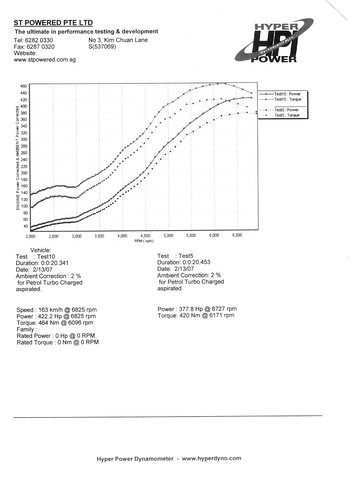
Thursday, February 01, 2007
Ferrari F430
Of course everyone wanted to know how it goes. "It feels slower than the Evo for some reason..." Yeah right! It's 4.3L worth of Italian V8 goodness dude!
So we're standing around admiring this exquisite work of automotive art and he says "Hey let's go for a ride." He didn't have to ask twice!!
The dashboard is in hand-stitched black leather ... nice :) Fires it up and the burbly V8 comes to life. Quick dab on the throttle brings the engine to a lovely hum, a lot more bassy than the F360's shriek.
Driving slowly out of the compound, we check for traffic both ways. Manettino set to "Race". All clear! Make a left turn, straighten the steering wheel, and floor it! The rear wheels chirp as the traction control struggles to bring the car in line, but we're still accelerating strongly to the 8500 RPM red line... upshift into 2nd, the gear change is hard and brutal. The car is still pulling hard, and into 3rd. A car ahead slows so he shuts it down.
Repeat.
My initial impressions... it's got good mid-range torque. He's right. It doesn't feel as raw as Sam's car in the first few gears. But the power never flags even towards rev limiter. Should be a real highway monster.
The car is on overrun when the foot is off the throttle so that should result in the occasional fireball out the exhaust. The sound of it is something that never gets old.
Hopefully he'll bring it to our next trackday so we have some idea of what it can do. I'll sure be looking forward to it. :)
Friday, January 26, 2007

You are The Hermit
Prudence, Caution, Deliberation.
The Hermit points to all things hidden, such as knowledge and inspiration,hidden enemies. The illumination is from within, and retirement from participation in current events.
The Hermit is a card of introspection, analysis and, well, virginity. You do not desire to socialize; the card indicates, instead, a desire for peace and solitude. You prefer to take the time to think, organize, ruminate, take stock. There may be feelings of frustration and discontent but these feelings eventually lead to enlightenment, illumination, clarity.
The Hermit represents a wise, inspirational person, friend, teacher, therapist. This a person who can shine a light on things that were previously mysterious and confusing.
What Tarot Card are You?
Take the Test to Find Out.
O RLY?
Via Ben
Friday, January 12, 2007

05 Subaru WRX (EJ25) with DBW throttle conversion, FMIC, HKS 3037 turbo, HKS EVC 5 BC, fueling mods, AEM. Stock head and cams. Short block rebuilt using stock pistons, rods, bearings etc. Chart provided by customer; recorded 350 whp @ 1.33 bar. Fixed the dip in torque at the upper range.
Some quick calculations to validate the observed data:
44 lb/min of air is needed to produce 415 bhp.
Assuming intake air temperature is 40 degC, VE of 97%.
Therefore required MAP pressure is 44 * 639.6 * (460+104) / 0.97 * 3200 * 151.25 = 33.8 psi absolute, or gauge pressure of 33.8 - 14.5 = 19.3 psi. Or 1.33 bar of boost pressure.
Tuesday, January 09, 2007
More Evo X Prototype pix
http://www.leftlanenews.com/2007/01/08/mitsubishi-prototype-x-breaks-cover/
Tuesday, January 02, 2007
Evo 9 MR GSR tuned
 Best Motoring Jan 07 tests the Evo 9 MR RS vs the STI Spec C... on the left are the stats for the Evo. It differs quite significantly from official Mitsubishi marketing literature (i.e. the latter is understated).
Best Motoring Jan 07 tests the Evo 9 MR RS vs the STI Spec C... on the left are the stats for the Evo. It differs quite significantly from official Mitsubishi marketing literature (i.e. the latter is understated). Here is a dyno chart of an JDM 9 MR GSR that was tuned on Saturday. Mods are open pod intake, 2-3/4" exhaust, cat delete, EVC boost control set at 1.4 bar tapering to 1.2 at peak, and ECU reflash. Figures are at wheels. Take a close look at where the peak torque numbers are generated... if the accelerator wasn't let off so early it might've made peak power at 6500 RPM.
Here is a dyno chart of an JDM 9 MR GSR that was tuned on Saturday. Mods are open pod intake, 2-3/4" exhaust, cat delete, EVC boost control set at 1.4 bar tapering to 1.2 at peak, and ECU reflash. Figures are at wheels. Take a close look at where the peak torque numbers are generated... if the accelerator wasn't let off so early it might've made peak power at 6500 RPM.The other interesting thing to note is that this car makes 240 lb-ft of torque, at wheels, from 3500 to almost 6500 RPM, or almost 43% of the usable rev range. Not too shabby.
Oh, as for the link to the Best Motoring vid, it's hosted on Youtube here.
